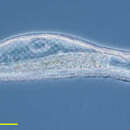pt-BR
nomes no trilho de navegação


The Chaetonotida is an order of gastrotrichs. They generally have a tenpin or bottle-like shape.
Chaetonotids inhabit both freshwater and marine environments. They can be distinguished from other gastrotrichs by the absence of pores in the pharynx, and by the presence of adhesive glands at the posterior end of the animal only. Most freshwater species are parthenogenetic.
The smooth or complex cuticle has a variable number of adhesive tubes, and the pharyngeal lumen of Chaetonotids is Y-shaped. A valve may be present at the junction of the pharynx and midgut. The epidermis in most organisms in this order is partly syncytial. The Chaetonotids are divided into two suborders, Multitubulatina and Paucitubulatina. Multitubulatina are marine, hermaphroditic strap-shaped organisms. Paucitubulatina are mostly freshwater, bowling pin shaped organisms that can be hermaphroditic, parthenogenetic or both.[1]
The Chaetonotida is an order of gastrotrichs. They generally have a tenpin or bottle-like shape.
Chaetonotids inhabit both freshwater and marine environments. They can be distinguished from other gastrotrichs by the absence of pores in the pharynx, and by the presence of adhesive glands at the posterior end of the animal only. Most freshwater species are parthenogenetic.
The smooth or complex cuticle has a variable number of adhesive tubes, and the pharyngeal lumen of Chaetonotids is Y-shaped. A valve may be present at the junction of the pharynx and midgut. The epidermis in most organisms in this order is partly syncytial. The Chaetonotids are divided into two suborders, Multitubulatina and Paucitubulatina. Multitubulatina are marine, hermaphroditic strap-shaped organisms. Paucitubulatina are mostly freshwater, bowling pin shaped organisms that can be hermaphroditic, parthenogenetic or both.
Los quetonótidos (Chaetonotida) son un orden de gastrotricos que habitan tanto en ambientes de agua dulce como marinos.
Se pueden distinguir de otros gastrotricos por la ausencia de poros en la faringe y por la presencia de glándulas adhesivas en el extremo posterior del animal solamente. La mayoría de las especies de agua dulce se reproducen por partenogénesis. La cutícula lisa o compleja tiene un número variable de tubos adhesivos y la luz faríngea de los quetonotidos tiene forma de Y. Una válvula puede estar presente en la unión de la faringe y el intestino medio. La epidermis en la mayoría de los organismos en este orden es en parte sincitial. Los quetonotidos se dividen en dos subórdenes, Multitubulatina y Paucitubulatina. Los Multitubulatina son organismos marinos, hermafroditas en forma de correa. Paucitubulatina son en su mayoría organismos de agua dulce en forma de botellas que pueden ser hermafroditas, partenogenéticos o ambos.[1][2]
La taxonomía del orden es la siguiente según el WoRMS:[3]
Los quetonótidos (Chaetonotida) son un orden de gastrotricos que habitan tanto en ambientes de agua dulce como marinos.
Se pueden distinguir de otros gastrotricos por la ausencia de poros en la faringe y por la presencia de glándulas adhesivas en el extremo posterior del animal solamente. La mayoría de las especies de agua dulce se reproducen por partenogénesis. La cutícula lisa o compleja tiene un número variable de tubos adhesivos y la luz faríngea de los quetonotidos tiene forma de Y. Una válvula puede estar presente en la unión de la faringe y el intestino medio. La epidermis en la mayoría de los organismos en este orden es en parte sincitial. Los quetonotidos se dividen en dos subórdenes, Multitubulatina y Paucitubulatina. Los Multitubulatina son organismos marinos, hermafroditas en forma de correa. Paucitubulatina son en su mayoría organismos de agua dulce en forma de botellas que pueden ser hermafroditas, partenogenéticos o ambos.
Chaetonotida zijn een orde van de buikharigen. De wetenschappelijke naam van de orde werd voor het eerst geldig gepubliceerd in 1925 door Remane[2] als Chaetonotida.[1]
Chaetonotida bewonen zowel zoetwater als marine milieus. Ze kunnen onderscheiden worden van andere buikharigen door de afwezigheid van poriën in de keelholte. De meeste zoetwatersoorten kennen parthenogenese.
De volgende taxa zijn bij de orde ingedeeld:
Chaetonotida zijn een orde van de buikharigen. De wetenschappelijke naam van de orde werd voor het eerst geldig gepubliceerd in 1925 door Remane als Chaetonotida.
Chaetonotida bewonen zowel zoetwater als marine milieus. Ze kunnen onderscheiden worden van andere buikharigen door de afwezigheid van poriën in de keelholte. De meeste zoetwatersoorten kennen parthenogenese.
Chaetonotida é uma ordem de vermes do filo Gastrotricha.
Ordem Chaetonotida Remane, 1924
Chaetonotida é uma ordem de vermes do filo Gastrotricha.

イタチムシ目は、淡水ではごく普通に見られる微生物である。
イタチムシは、腹毛動物門イタチムシ目に属するものの総称、またはこれに属する種Chaetonotus nodicaususの和名である。この項ではイタチムシ目一般について説明する。
体長は多くが200μmほど。体は細長く、左右対称、腹面と背面ははっきりしている。前の端がやや幅広くなって、頭部らしい形になり、真ん中より前方でなだらかに細まった後、再び幅広くなって腹部っぽい形になる。最後の端はわずかに細まった後、二股に分かれて終わる。
顕微鏡下で体はほぼ透明に見える。全身がクチクラに覆われており、全体の形を整えたまま伸び縮みや屈伸運動ができる。多くのものは体表を鱗状の構造で覆う。イタチムシなどChaetonotusでは、体の表面は多数の刺に覆われているように見える。これは、体表にある鱗に後ろに曲がった刺が生えているものである。そのために表面に毛がはえているようにも見えるから、細長い体をくねらせてはい回る姿は確かにイタチを思わせる。
頭部には先端に口が開いている。そのやや後方の両側には感覚毛束と呼ばれる毛の束があり、感覚をつかさどっているらしい。それ以降の後端までに背中から見える外部の構造は特にない。後端は二つに割れて、その先端は種によっては長く伸びて尾叉となる。
腹面には左右二列の繊毛帯がある。これによって他物の表面をはい回って生活している。活動は活発で、滑らかに前進し、刺激を受けると縮まり、時には腹部後方の粘着管で基盤に一時的に張り付く。また、水中に泳ぎ出ることも少しはある。
富栄養の浅い水域の水草の表面や沈殿物の間などではごく普通に見られる。
イタチムシ目(毛遊目)は5科19属334種、日本では3科8属45種[1]。